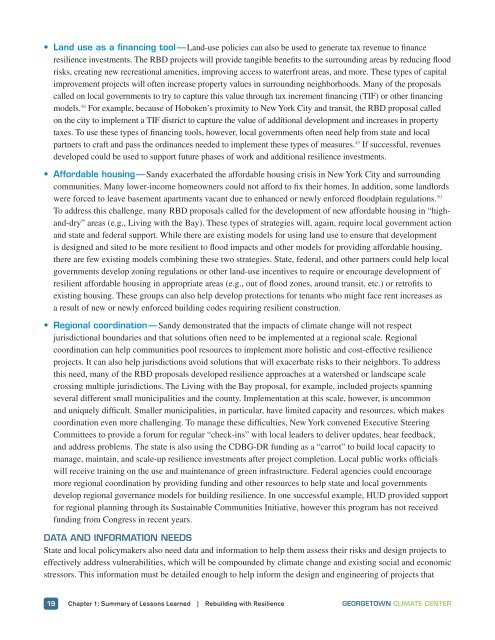Rebuilding with Resilience
dw0r306aHfX
dw0r306aHfX
You also want an ePaper? Increase the reach of your titles
YUMPU automatically turns print PDFs into web optimized ePapers that Google loves.
• Land use as a financing tool — Land-use policies can also be used to generate tax revenue to finance<br />
resilience investments. The RBD projects will provide tangible benefits to the surrounding areas by reducing flood<br />
risks, creating new recreational amenities, improving access to waterfront areas, and more. These types of capital<br />
improvement projects will often increase property values in surrounding neighborhoods. Many of the proposals<br />
called on local governments to try to capture this value through tax increment financing (TIF) or other financing<br />
models. 48 For example, because of Hoboken’s proximity to New York City and transit, the RBD proposal called<br />
on the city to implement a TIF district to capture the value of additional development and increases in property<br />
taxes. To use these types of financing tools, however, local governments often need help from state and local<br />
partners to craft and pass the ordinances needed to implement these types of measures. 49 If successful, revenues<br />
developed could be used to support future phases of work and additional resilience investments.<br />
• Affordable housing — Sandy exacerbated the affordable housing crisis in New York City and surrounding<br />
communities. Many lower-income homeowners could not afford to fix their homes. In addition, some landlords<br />
were forced to leave basement apartments vacant due to enhanced or newly enforced floodplain regulations. 50<br />
To address this challenge, many RBD proposals called for the development of new affordable housing in “highand-dry”<br />
areas (e.g., Living <strong>with</strong> the Bay). These types of strategies will, again, require local government action<br />
and state and federal support. While there are existing models for using land use to ensure that development<br />
is designed and sited to be more resilient to flood impacts and other models for providing affordable housing,<br />
there are few existing models combining these two strategies. State, federal, and other partners could help local<br />
governments develop zoning regulations or other land-use incentives to require or encourage development of<br />
resilient affordable housing in appropriate areas (e.g., out of flood zones, around transit, etc.) or retrofits to<br />
existing housing. These groups can also help develop protections for tenants who might face rent increases as<br />
a result of new or newly enforced building codes requiring resilient construction.<br />
• Regional coordination — Sandy demonstrated that the impacts of climate change will not respect<br />
jurisdictional boundaries and that solutions often need to be implemented at a regional scale. Regional<br />
coordination can help communities pool resources to implement more holistic and cost-effective resilience<br />
projects. It can also help jurisdictions avoid solutions that will exacerbate risks to their neighbors. To address<br />
this need, many of the RBD proposals developed resilience approaches at a watershed or landscape scale<br />
crossing multiple jurisdictions. The Living <strong>with</strong> the Bay proposal, for example, included projects spanning<br />
several different small municipalities and the county. Implementation at this scale, however, is uncommon<br />
and uniquely difficult. Smaller municipalities, in particular, have limited capacity and resources, which makes<br />
coordination even more challenging. To manage these difficulties, New York convened Executive Steering<br />
Committees to provide a forum for regular “check-ins” <strong>with</strong> local leaders to deliver updates, hear feedback,<br />
and address problems. The state is also using the CDBG-DR funding as a “carrot” to build local capacity to<br />
manage, maintain, and scale-up resilience investments after project completion. Local public works officials<br />
will receive training on the use and maintenance of green infrastructure. Federal agencies could encourage<br />
more regional coordination by providing funding and other resources to help state and local governments<br />
develop regional governance models for building resilience. In one successful example, HUD provided support<br />
for regional planning through its Sustainable Communities Initiative, however this program has not received<br />
funding from Congress in recent years.<br />
DATA AND INFORMATION NEEDS<br />
State and local policymakers also need data and information to help them assess their risks and design projects to<br />
effectively address vulnerabilities, which will be compounded by climate change and existing social and economic<br />
stressors. This information must be detailed enough to help inform the design and engineering of projects that<br />
19 Chapter 1: Summary of Lessons Learned | <strong>Rebuilding</strong> <strong>with</strong> <strong>Resilience</strong> GEORGETOWN CLIMATE CENTER


